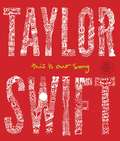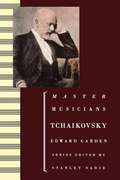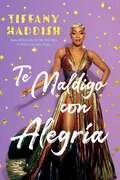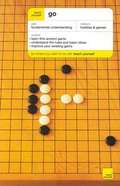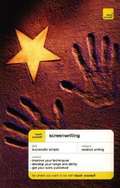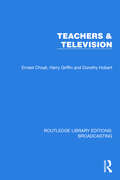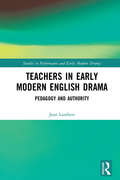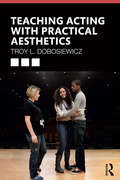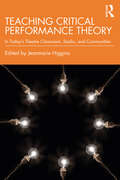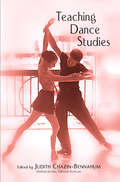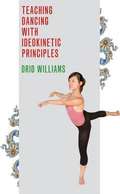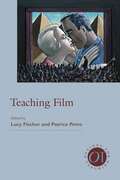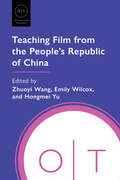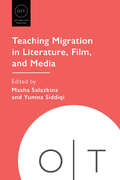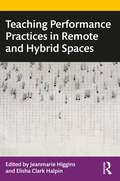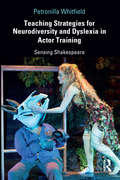- Table View
- List View
Taylor Swift: This Is Our Song
by Tyler ConroyA book about Taylor. Made with love. By fans. For fans.Ten years ago, an unknown sixteen-year-old released a self-titled debut country album. A decade later, Taylor Swift has reached record-breaking, chart-topping heights. A ten-time Grammy winner, Swift has been hailed for her songwriting talent, crossed effortlessly from country to pop, and established herself as a musician who can surprise, delight, and inspire, all while connecting with her fans in a way that only she can. Amazingly, after all these years, there is no great, comprehensive book about Swift for her fans. Until now. This book, a fan-generated celebration of Swift's first decade as an artist, collects the best writing and images from the past ten years in one gorgeous volume. From prefame interviews with Swift in local Pennsylvania newspapers to major profiles in The New Yorker and Rolling Stone; from album reviews by top critics such as Robert Christgau, Sasha Frere-Jones, and Ann Powers to essays by beloved novelists like Maggie Shipstead; from Tavi Gevinson's classic ode to Swift in The Believer to Q&As with Chuck Klosterman and humorous analysis from McSweeney's and The Hairpin; from album-themed crossword puzzles and adult coloring pages to profiles of Taylor's biggest fans; from an excerpt of the soon-to-be-published novel Taylor Swift: Girl Detective to a "book within a book" of Swift's most inspiring quotations titled (naturally) The Tao of Tay, this book is the vital collection of all things Taylor. Here, finally, is the must-have book for every Swiftie and every music lover. For, as Klosterman wrote in GQ, "If you don't take Swift seriously, you don't take contemporary music seriously." * This book is a tribute to Taylor Swift, but she was not involved in its creation. *
Tchaikovsky
by Edward GardenRevised to mark the centenary of Tchaikovsky's death and the recent upsurge of interest in his music, Edward Garden's study assesses the operas, ballets and other works against the background of the composer's eventful life: his ill-judged marriage, his curious pen-friendship with his patron Nadezhda von Meck, and his relationship with Balakirev and other Russian composers. Edward Garden also examines conflicting theories on the manner of Tchaikovsky's death.
Tchaikovsky in America
by Elkhonon YoffeBiography of the famous composer, including his trip to New York in 1891 to celebrate the opening of Carnegie Hall.
Te Maldigo con Alegría / I Curse You With Joy
by Tiffany HaddishFrom the author of The Coppersmith Farmhouse and The Lucky Heart comes another standalone novel in the Jamison Valley Series, perfect for fans of Helen Hardt, Kristen Ashley, and Linda Howard.Tiffany Haddish está de regreso con su nueva y muy esperada colección de ensayos, Te Maldigo con Alegría.La última vez que los lectores se sentaron con Tiffany Haddish fue con su exitoso debut El Ultimo Unicornio Negro. Desde entonces, se catapultó a la fama como estrella de Girls Trip. Desfiló por la alfombra roja de los Oscar, estrenó exitosas comedias en Showtime y Netflix y pasó a la historia como la primera comediante negra en presentar Saturday Night Live y Shark Week.Pero no todo ha sido una fiesta. En estos ensayos humorísticos y sentidos, Tiffany se enfrenta a los altibajos de la vida. Hubo una época en la que Tiffany no sabía del todo quién era Tiffany. Antes de descubrir su propio estilo, se presentaba en el escenario vestida como sus compañeras de trabajo en la aerolínea para contar insípidos chistes de pitos. Se hundió. Fue necesario un pene falso, la ayuda de algunos amigos y un poco de apoyo de Bob Saget para que Tiffany descubriera quién era Tiffany. En este libro, Tiffany se enfrenta a sus traumas de infancia, a los desafíos de ser mujer negra en la industria del entretenimiento y a su agridulce reencuentro con su padre después de casi veinte años.Te Maldigo con Alegría es Tiffany Haddish sin filtros, invitando al lector a su intimidad, donde la alegría, la honestidad, el amor y el corazón están a la orden del día. ENGLISH DESCRIPTIONTiffany Haddish is back with her highly anticipated new essay collection, I Curse You With Joy.It's been a minute. Readers last sat down with Tiffany in her bestselling debut The Last Black Unicorn. Since then, Haddish has catapulted to A-list fame as the breakout start of Girls Trip. She's walked the Oscars red carpet, released a hit stand-up special with Netflix, and made history as the first Black female comedian to host Saturday Night Live and Shark Week. But it hasn't been all VIP parties and free diving with apex predators. In these humorous and heartfelt essays, Tiffany gets real about the highs and lows of life. Believe it or not, there was a time when Tiffany didn't totally know who Tiffany was. Before she found her groove, she was on stage dressed like her snobby airline coworkers telling halfhearted dick jokes. She tanked. It took a fake penis, some help from friends, and a little encouragement from Bob Saget, but eventually Tiffany figured out Tiffany. I Curse You With Joy celebrates all the lessons she learned along the way--the joy and the pain. Tiffany reckons with the legacy of her childhood trauma, the challenges of being a Black woman in the entertainment industry, and her bittersweet reunion with her estranged father after twenty years apart. Don't worry, she's got plenty of advice to share, too. I Curse You With Joy is Tiffany Haddish unfiltered. (We know what you're thinking...how much more unfiltered can she get?) These essays lay it all bare, bringing readers into Tiffany's inner circle where joy, honesty, humor, and heart are the order of the day.
Teach Yourself Basic Guitar
by Simon Pitt Simon TroupThe core information that you will learn in this book will be useful to you whichever styles of popular music you may later choose to specialize in. Whether you want to play rock, pop, blues, reggae, funk, folk or jazz, you'll need to start developing good left- and right-hand technique, and learn the chords and scales that are the building blocks of almost all western popular music. While this book doesn't go into any depth on classical guitar technique, there is a great deal of information and advice that will be of benefit to anyone who may decide that they wish to specialize in classical guitar playing in the future.
Teach Yourself Digital Home Movie Making
by Peter Cope'Digital' is a term that is bandied around often by marketeers who see it as a synonym for 'cutting edge' and it now appears in almost every walk of life: digital radio, digital phones, digital cameras. Digital, in its most common, if clinical, meaning describes the way in which real world information -- such as sound, colour and light -- are converted into numeric form. When we talk about digital video the key distinguishing feature is its quality. A digital video signal -- such as that produced by a sensor in a digital camera -- doesn't suffer degradation in the same way as an analogue signal. A single frame of video will be more sharply defined than that from an equivalent analogue camera. Digital video really comes into its own when we start thinking about editing. The book teaches you everything related to Digital Home Movie Making.
Teach Yourself Film Making
by Tom HoldenA straightforward guide for people who have been trying to make films, with all the techniques to succeed.
Teach Yourself Film Studies
by Warren BucklandTo study film should not be thought of as an activity inferior to studying other arts, such as theatre, painting or opera, for two reasons. Firstly, film occupies a dominant place in society and because film is a popular medium, it should be studied seriously. Secondly, if the film student adopts a serious, responsible and critical approach to film, then film studies becomes as important as any other type of study. Ultimately, it is the student's attitude that justifies the study of film, not the nature or popularity of film. If the student takes his or her task seriously, then studying Steven Spielberg's film The Lost World: Jurassic Park becomes as important and legitimate as studying Shakespeare's play Hamlet, Hans Holbein's painting The Ambassadors or Mozart's opera The Magic Flute. the cinema is not so difficult to explain once you become familiar with the main critical tools film scholars use to analyse films. As a secondary aim, we shall look at films that are not easy to understand and we shall see what makes them difficult. By analysing the complex nature of difficult films we should be able to appreciate them more.
Teach Yourself Go
by Charles MatthewsConsisting of black and white pebbles and a grid-work playing board, the ancient Asian game of go appears much simpler than chess, but it continues to stump the most sophisticated supercomputers. Teach Yourself Go explains the rules of the game and, using step-by-step illustrations, helps you acquire a solid understanding of how go is played. You also learn about the origins of the game, its long history, and the body of legend, rituals, art, and literature that it has inspired.
Teach Yourself Guitar
by Dale FraddTeach Yourself Guitar is an essential guide for anyone who wants to learn how to play this beautiful instrument. It will take you from choosing your guitar and tuning it, to reading the music and actually playing it.
Teach Yourself Screenwriting
by Raymond G. FrenshamMany readers dream of seeing their stories on the silver screen, but most do not know how to write a screenplay, let alone get their script into the right hands. For those readers wanting the "how-tos" of Hollywood, Teach Yourself Screenwriting is an easy-to-comprehend yet thorough introduction to this art. Here they will get the basics and advice on how to get their work onto celluloid. This book covers the techniques and specialized skills used in writing for this visual medium and answers the practical questions often asked by budding screenwriters.
Teachers & Television (Routledge Library Editions: Broadcasting #32)
by Ernest Choat Harry Griffin Dorothy HobartTeachers & Television (1987) examines the use of television in education. With television being the most powerful medium of mass communication, with tremendous potential as an educational tool, to what extent are teachers considering educational television as a component of the curriculum? This book looks at children’s reactions to educational television, their abilities to process information, and the uses of educational television by schools.
Teachers Are Funny!
by Hyman AlpernClean Old fashioned jokes about teachers, parents, students, classes and subjects, sports, art and much more.
Teachers in Early Modern English Drama: Pedagogy and Authority (Studies in Performance and Early Modern Drama)
by Jean LambertStarting from the early modern presumption of the incorporation of role with authority, Jean Lambert explores male teachers as representing and engaging with types of authority in English plays and dramatic entertainments by Shakespeare and his contemporaries from the late sixteenth to the early seventeenth century. This book examines these theatricalized portraits in terms of how they inflect aspects of humanist educational culture and analyzes those ideas and practices of humanist pedagogy that carry implications for the traditional foundations of authority. Teachers in Early Modern English Drama is a fascinating study through two centuries of teaching Shakespeare and his contemporaries and will be a valuable resource for undergraduates, postgraduates, and scholars interested in sixteenth- and seventeenth-century drama, writing, and culture.
Teaching Acting with Practical Aesthetics
by Troy DobosiewiczTeaching Acting with Practical Aesthetics uses constructivist pedagogy to teach acting via Practical Aesthetics, a system of actor training created in the mid-1980s by David Mamet. The book melds the history of Practical Aesthetics, Practical Aesthetics itself, educational theory, and compatible physical work into the educational approach called Praxis to create a comprehensive training guide for the modern actor and theatre instructor. It includes lesson plans, compatible voice and movement exercises, constructivist teaching materials, classroom handouts, and a suggested calendar for Acting courses. Written for Acting instructors at the college and secondary levels, Acting scholars, and professionals looking for a new way to perform, Teaching Acting with Practical Aesthetics offers detailed instructions to help students sharpen their performing skills and excel on stage.
Teaching Comedy (Options for Teaching)
From Shakespeare to The Simpsons, comedy has long provided both entertainment and social commentary. It may critique cultural values, undermine authority, satirize sacred beliefs, and make room for the marginalized to approach the center. Comedy can be challenging to teach, but in the classroom it can help students connect with one another, develop critical thinking skills, and engage with important issues.The essays in this volume address a rich variety of texts spanning film, television, stand-up, cartoons, and memes as well as conventional literary works from different places and times. Contributors offer theoretical foundations and practical methods for a broad range of courses, including guidance on contextualizing the humor of historical works and on navigating the ways that comedy can both subvert and reinforce stereotypes. Finally, the volume argues for the value of comedy in difficult times, as a way to create community and meaning.This volume contains discussion of fiction, poetry, plays, and essays by Maya Angelou, Jane Austen, Aphra Behn, Hugh Henry Brackenridge, Frances Burney, Charles W. Chesnutt, Roddy Doyle, Maria Edgeworth, Ben Jonson, Anita Loos, Emtithal Mahmoud, Thomas Middleton, Okot p'Bitek, William Shakespeare, Laurence Sterne, Jonathan Swift, Alma Villanueva, Paula Vogel, Oscar Wilde, John Wilmot, and William Wycherley; TV shows and films including Crazy Ex-Girlfriend, The Gold Rush, Life Is Beautiful, The Marvelous Mrs. Maisel, The Office, Office Space, Rick and Morty, and South Park; works and stand-up performances by Aziz Ansari, Samantha Bee, Dave Chappelle, Louis C.K., Tina Fey, Moms Mabley, Hasan Minhaj, Eddie Murphy, Trevor Noah, Richard Pryor, Issa Rae, and Wanda Sykes; and visual works and other media including Aaron McGruder's The Boondocks, Bill Watterson's Calvin and Hobbes, Nick Sousanis's Unflattening, Marvel's Hawkeye, The Onion, YouTube videos, advertisements, and memes.
Teaching Critical Performance Theory: In Today’s Theatre Classroom, Studio, and Communities
by Jeanmarie HigginsTeaching Critical Performance Theory offers teaching strategies for professors and artist-scholars across performance, design and technology, and theatre studies disciplines. The book’s seventeen chapters collectively ask: What use is theory to an emerging theatre artist or scholar? Which theories should be taught, and to whom? How can theory pedagogies shape and respond to the evolving needs of the academy, the field, and the community? This broad field of enquiry is divided into four sections covering course design, classroom teaching, the studio space, and applied theatre contexts. Through a range of intriguing case studies that encourage thoughtful theatre practice, this book explores themes surrounding situated learning, dramaturgy and technology, disability and inclusivity, feminist approaches, race and performance, ethics, and critical theory in theatre history. Written as an invaluable resource for professionals and postgraduates engaged in performance theory, this collection of informative essays will also provide critical reading for those interested in drama and theatre studies more broadly.
Teaching Dance Studies
by Judith Chazin-Bennahum Melinda JordanTeaching Dance Studies is a practical guide, written by college professors and dancers/choreographers active in the field, introducing key issues in dance pedagogy. Many young people graduating from universities with degrees – either PhDs or MFAs – desire to teach dance, either in college settings or at local dance schools. This collection covers all areas of dance education, including improvisation/choreography; movement analysis; anthropology; theory; music for dance; dance on film; kinesiology/injury prevention; notation; history; archiving; and criticism. Among the contributors included in the volume are: Bill Evans, writing on movement analysis; Susan Foster on dance theory; Ilene Fox on notation; Linda Tomko addresses new approaches to teaching the history of all types of dance; and Elizabeth Aldrich writing on archiving.
Teaching Dancing with Ideokinetic Principles
by Drid WilliamsIn examining ideokinesis and its application to the teaching and practice of dancing, Drid Williams introduces readers to the work of Dr. Lulu Sweigard (1895–1974), a pioneer of ideokinetic principles. Drawing on her experiences during private instructional sessions with Sweigard over a two-year span, Williams discusses methods using imagery for improving body posture and alignment for ease of movement. Central to Williams's own teaching methods is the application of Sweigard's principles and general anatomical instruction, including how she used visual imagery to help prevent bodily injuries and increasing body awareness relative to movement. Williams also emphasizes the differences between kinesthetic (internal) and mirror (external) imagery and shares reactions from professional dancers who were taught using ideokinesis. Williams's account of teaching and practicing ideokinesis is supplemented with essays by Sweigard, William James, and Jean-Georges Noverre on dancing, posture, and habits. Teaching Dancing with Ideokinetic Principles offers an important historical perspective and valuable insights from years of teaching experience into how ideokinesis can shape a larger philosophy of the dance.
Teaching Film (Options for Teaching #35)
by Patricia White Mark Lynn Anderson Adam Lowenstein Hamid Naficy Dudley Andrew Timothy Corrigan Anne Rutherford Tasha Oren Garrett Stewart E. Ann Kaplan Gwendolyn Audrey Foster Michael Renov Pat Brereton David Desser Maureen Turim Paula J. Massood Michael Aronson Nataša Ďurovičová Mark LangerFilm studies has been a part of higher education curricula in the United States almost since the development of the medium. Although the study of film is dispersed across a range of academic departments, programs, and scholarly organizations, film studies has come to be recognized as a field in its own right. In an era when teaching and scholarship are increasingly interdisciplinary, film studies continues to expand and thrive, attracting new scholars and fresh ideas, direction, and research.Given the dynamism of the field, experienced and beginning instructors alike need resources for bringing the study of film into the classroom. This volume will help instructors conceptualize contemporary film studies in pedagogical terms. The first part of the volume features essays on theory and on representation, including gender, race, and sexuality. Contributors then examine the geographies of cinema and offer practical suggestions for structuring courses on national, regional, and transnational film. Several essays focus on interdisciplinary approaches, while others describe courses designed around genre (film noir, the musical), mode (animation, documentary, avant-garde film), or the formal elements of film, such as sound, music, and mise-en-scène. The volume closes with a section on film and media in the digital age, in which contributors discuss the opportunities and challenges presented by access to resources, media convergence, and technological developments in the field.
Teaching Film from the People's Republic of China (Options for Teaching)
by Zhuoyi Wang, Emily Wilcox, and Hongmei YuThis volume brings a diverse range of voices--from anthropology, communication studies, ethnomusicology, film, history, literature, linguistics, sociology, theater, and urban geography--into the conversation about film from the People's Republic of China. Essays seek to answer what films can reveal or obscure about Chinese history and society and demonstrate how studying films from the PRC can introduce students to larger issues of historical consciousness and media representation.The volume addresses not only postsocialist fictional films but also a wide variety of other subjects including socialist period films, documentaries, films by or about people from ethnic minority groups, film music, the perspectives of female characters, martial arts cinema, and remakes of South Korean films. By exploring how films represent power, traditions, and ideologies, students learn about both the complexity of the PRC and the importance of cross-cultural and cross-ideological understanding.
Teaching Migration in Literature, Film, and Media (Options for Teaching)
by Yumna Siddiqi Masha SalazkinaPeople migrate to seek opportunities, to unite with family, and to escape war, persecution, poverty, and environmental disasters. A phenomenon that has real, lived effects on individuals and communities, migration also carries symbolic, ideological significance. Its depiction in literature, film, and other media powerfully shapes worldviews, identities, attitudes toward migrants, and a political landscape that is both local and global. It is imperative, then, to connect the disciplinary and theoretical tools we have for understanding migration and to put them in conversation with students' experiences.Featuring a wide range of classroom approaches, this volume brings together topics that are often taught separately, including tourism, slavery, drug cartels, race, whiteness, settler colonialism, the Arab Spring, assimilation, and disability. Readers are introduced to terminology and legal frameworks and to theories of migration in relation to Black studies, ethnic studies, Asian American studies, Latinx studies, border studies, postcolonial studies, and Indigenous studies.
Teaching Performance Practices in Remote and Hybrid Spaces
by Jeanmarie HigginsThis collection of insightful essays gives teachers’ perspectives on the role of space and presence in teaching performance. It explores how the demand for remote teaching can be met while at the same time successfully educating and working compassionately in this most ‘live’ of disciplines. Teaching Performance Practices in Remote and Hybrid Spaces reframes prevailing ideas about pedagogy in dance, theatre, and somatics and applies them to teaching in face-to-face, hybrid, and remote situations. Case studies from instructors and professors provide essential, practical suggestions for remotely teaching a vast range of studio courses, including tap dance, theatre design, movement, script analysis, and acting, rendering this book an invaluable resource. The challenges that teachers are facing in the early twenty-first century are addressed throughout, helping readers to navigate these unprecedented circumstances whilst delivering lessons, guiding workshops, rehearsing, or even staging performances. This book is invaluable for dance and theatre teachers or leaders who work in the performing arts and related disciplines. It is also ideal for any professionals who need research-based solutions for teaching performance online.
Teaching Strategies for Neurodiversity and Dyslexia in Actor Training: Sensing Shakespeare
by Petronilla WhitfieldTeaching Strategies for Neurodiversity and Dyslexia in Actor Training addresses some of the challenges met by acting students with dyslexia and highlights the abilities demonstrated by individuals with specific learning differences in actor training. The book offers six tested teaching strategies, created from practical and theoretical research investigations with dyslexic acting students, using the methodologies of case study and action research. Utilizing Shakespeare’s text as a laboratory of practice and drawing directly from the voices and practical work of the dyslexic students themselves, the book explores: the stress caused by dyslexia and how the teacher might ameliorate it through changes in their practice the theories and discourse surrounding the label of dyslexia the visual, kinaesthetic, and multisensory processing preferences demonstrated by some acting students assessed as dyslexic acting approaches for engaging with Shakespeare’s language, enabling those with dyslexia to develop their authentic voice and abilities a grounding of the words and the meaning of the text through embodied cognition, spatial awareness, and epistemic tools Stanislavski’s method of units and actions and how it can benefit and obstruct the student with dyslexia when working on Shakespeare Interpretive Mnemonics as a memory support and hermeneutic process, and the use of color and drawing towards an autonomy in live performance This book is a valuable resource for voice and actor training, professional performance, and for those who are curious about emancipatory methods that support difference through humanistic teaching philosophies.
